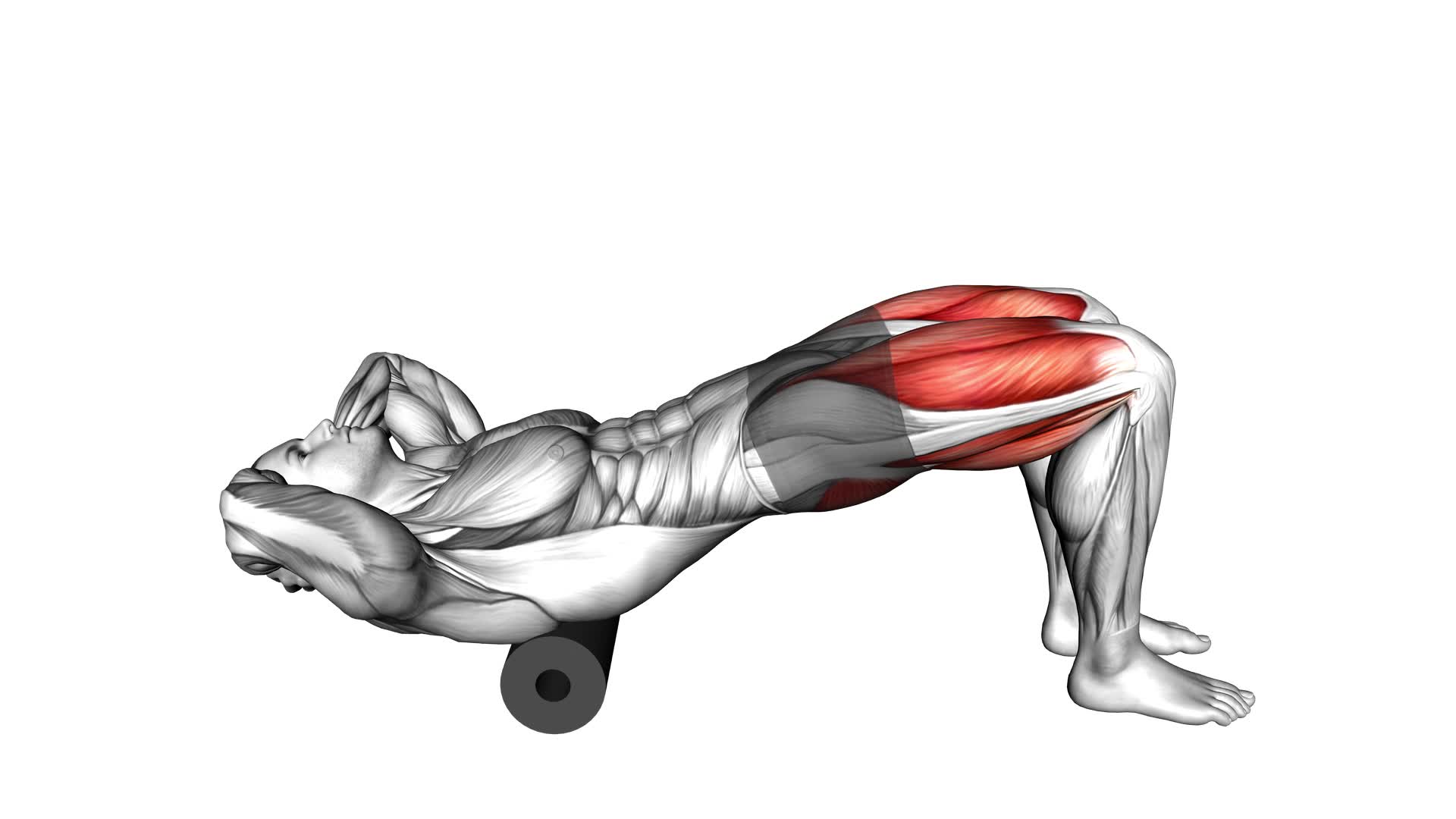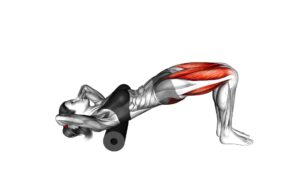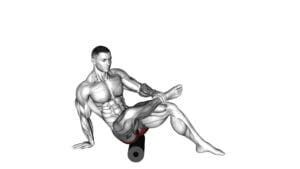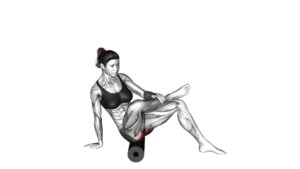Roll Hip Thrust (male) – Video Exercise Guide & Tips

Looking to strengthen your glutes and improve your lower body strength? The Roll Hip Thrust is the perfect exercise for you.
Watch This Exercise Video
In this video exercise guide, we'll show you the proper technique and provide helpful tips to maximize glute activation.
Avoid common mistakes and learn how to progress and increase intensity.
Get ready to feel the burn and see results with this effective exercise.
Let's get started!
Key Takeaways
- The roll hip thrust is highly effective in maximizing results for glutes and hamstrings.
- Proper technique and engaging the glute muscles throughout the movement is crucial for maximizing benefits.
- Common mistakes to avoid include leaning too far back, relying solely on momentum, neglecting proper form and not engaging the core.
- To increase intensity and progression, safely add weight, vary rep ranges, incorporate resistance bands, and focus on maintaining proper form and technique.
Benefits of the Roll Hip Thrust
You can experience significant benefits from incorporating the Roll Hip Thrust into your workout routine. This exercise is highly effective in maximizing results for your glutes and hamstrings. By performing the Roll Hip Thrust regularly, you can strengthen and tone these muscle groups, leading to a more sculpted and defined lower body.
One of the great things about the Roll Hip Thrust is its versatility. There are various variations and modifications that you can incorporate to target different aspects of your glutes and hamstrings. For example, you can try single-leg variations to increase the intensity and challenge your stability. Additionally, you can experiment with using resistance bands or weights to add resistance and further enhance muscle activation.
Another benefit of the Roll Hip Thrust is its ability to improve your overall hip mobility and stability. This exercise requires you to engage your core and maintain proper alignment, which can help improve your posture and reduce the risk of lower back pain.
Incorporating the Roll Hip Thrust into your workout routine can bring you significant benefits in terms of glute and hamstring development, mobility, and stability. So why not give it a try and start reaping these rewards today?
Proper Technique for the Roll Hip Thrust
To execute the Roll Hip Thrust with proper technique, there are several key points to keep in mind.
First, pay attention to your foot placement as it directly affects the activation of your glute muscles.
Second, focus on engaging your glutes throughout the movement to ensure maximum effectiveness.
Lastly, be aware of common mistakes such as using momentum or arching your back, as these can hinder the benefits of the exercise.
Foot Placement Importance
The proper technique for the Roll Hip Thrust involves placing your feet in an optimal position.
Foot placement is crucial for maximizing hip activation and getting the most out of this exercise.
When performing the Roll Hip Thrust, make sure to position your feet shoulder-width apart, with your toes pointing slightly outward. This stance helps to engage the glutes and activate the hips effectively.
Placing your feet too close together or too far apart can lead to improper form and reduce the effectiveness of the exercise.
By maintaining the correct foot placement, you ensure that the target muscles are properly engaged, leading to better results and minimizing the risk of injury.
Engaging Glute Muscles
To effectively engage your glute muscles during the Roll Hip Thrust, focus on maintaining proper form and using controlled movements. Glute activation is crucial for maximizing the benefits of this exercise.
Start by lying on your back with your knees bent and feet flat on the ground. Place your arms alongside your body for support.
As you lift your hips off the ground, make sure to squeeze your glutes and engage those muscles throughout the movement. This will help you target and strengthen your glute muscles effectively.
Avoid relying solely on momentum or using your lower back to lift your hips. Instead, focus on the contraction and engagement of your glutes to get the most out of the Roll Hip Thrust.
Common Mistakes to Avoid
Avoid using your lower back to lift your hips during the Roll Hip Thrust, as this can lead to improper technique and potential injury. To ensure you're maximizing your results and minimizing the risk of harm, be mindful of the following common mistakes:
- Leaning too far back: This puts excessive strain on your lower back and reduces the activation of your glute muscles.
- Relying solely on momentum: Using momentum to lift your hips takes away from the effectiveness of the exercise. Focus on controlled movements.
- Neglecting proper form: It's important to maintain a neutral spine and engage your core throughout the movement.
- Not fully extending the hips: Fully extending your hips at the top of the movement allows for maximum glute activation.
- Using too much weight: Adding too much weight can compromise your form and increase the risk of injury.
By avoiding these common mistakes, you can perform the Roll Hip Thrust with proper technique and maximize the benefits for your glute muscles.
Now let's move on to the next section about other common mistakes to avoid.
Common Mistakes to Avoid
Make sure you don't let your lower back round during the roll hip thrust exercise. One of the common mistakes people make is allowing their lower back to round, which can put unnecessary stress on the spine and reduce the effectiveness of the exercise. To avoid this mistake, focus on maintaining a neutral spine throughout the movement. Engage your core muscles and imagine a straight line running from your head to your tailbone. This will help keep your lower back in a safe and stable position.
Another common mistake to avoid isn't properly activating your glutes. The roll hip thrust is an excellent exercise for targeting the glute muscles, but if you're not activating them correctly, you won't get the full benefit. Before starting the exercise, take a moment to mentally connect with your glutes. Visualize them contracting and powering the movement. As you perform the roll hip thrust, focus on squeezing your glutes at the top of the movement and really engaging them throughout. This will ensure that you're targeting the correct muscles and maximizing the effectiveness of the exercise.
How to Progress and Increase Intensity
To progress and increase intensity in your roll hip thrusts, there are a few key strategies you can implement.
First, start by adding weight safely to challenge your muscles. This can be done by using a barbell or dumbbells placed on your hips.
Secondly, vary your rep ranges by incorporating both higher and lower repetitions to stimulate different muscle fibers.
Lastly, consider incorporating resistance bands into your roll hip thrusts to provide additional resistance and further enhance the intensity of the exercise.
Adding Weight Safely
How can you safely increase the intensity and progress in adding weight to your roll hip thrust exercise? When it comes to weight progression and injury prevention, there are a few key strategies you can implement:
- Start with lighter weights and gradually increase the load over time.
- Focus on maintaining proper form and technique throughout the movement.
- Use a spotter or trainer to ensure safety and provide guidance.
- Incorporate progressive overload by adding small increments of weight each session.
- Listen to your body and avoid pushing yourself too hard, as this can lead to injury.
By following these guidelines, you can safely and effectively increase the intensity of your roll hip thrust exercise while minimizing the risk of injury.
Now, let's explore another important aspect of this exercise: varying rep ranges.
Varying Rep Ranges
To progress and increase intensity in your roll hip thrust exercise, you can vary your rep ranges. One way to do this is by increasing the weight you use. As you become stronger, you can gradually add more weight to the exercise to challenge your muscles even further.
Another way to vary your rep ranges is by incorporating advanced variations of the roll hip thrust. This could include performing the exercise on an unstable surface or using different equipment, such as a barbell. By incorporating these advanced variations, you can continue to challenge your muscles and keep progressing in your fitness journey.
Now, let's explore another way to increase the intensity of your roll hip thrust exercise by incorporating resistance bands.
Incorporating Resistance Bands
To further increase the intensity of your roll hip thrust exercise, incorporate resistance bands. Resistance bands are a great tool for adding extra resistance and challenging your glute muscles in different ways. Here are five resistance band exercises you can incorporate into your roll hip thrust routine:
- Band-resisted Hip Thrusts: Place a resistance band just above your knees and perform the hip thrust as usual. The band will add resistance throughout the entire movement, targeting your glutes even more.
- Single-leg Band Hip Thrusts: Loop a resistance band around your working leg and anchor the other end to a stable object. Perform the hip thrust on one leg at a time to increase the challenge.
- Banded Glute Bridge: Place a resistance band just above your knees and perform a glute bridge, focusing on squeezing your glutes at the top of the movement.
- Band Walks: Step into a resistance band and take small steps sideways, maintaining tension in the band. This exercise targets the glute medius, which is important for hip stability.
- Banded Clamshells: Lie on your side with a resistance band just above your knees. Open and close your legs like a clamshell, focusing on squeezing your glutes.
By incorporating these resistance band exercises into your roll hip thrust routine, you can take your glute training to the next level and continue challenging yourself with advanced hip thrust variations.
Now, let's move on to the next section to discover some tips for maximizing glute activation.
Tips for Maximizing Glute Activation
Maximize glute activation by focusing on proper form and engaging in exercises targeting the glute muscles. To maximize glute activation, it's important to perform exercises correctly and with intention. One of the key factors in activating the glutes is maintaining a neutral spine throughout the movement. This means keeping your back straight and avoiding excessive arching or rounding. Engaging the core and squeezing the glutes at the top of each movement can also help maximize activation.
Another tip for maximizing glute activation is to incorporate glute activation exercises into your workout routine. These are exercises specifically designed to target and activate the glute muscles. Examples of glute activation exercises include glute bridges, clamshells, and donkey kicks. These exercises can be done with or without equipment, making them easily accessible for anyone looking to activate their glutes.
Additionally, using resistance bands can help increase glute activation. By placing the band around your thighs or ankles during exercises such as squats or lunges, you add resistance that specifically targets the glutes. This can result in increased activation and improved overall strength in the glute muscles.
Sample Workout Routine for the Roll Hip Thrust
To incorporate the roll hip thrust into your workout routine and maximize glute activation, follow this sample workout routine:
- Start with a dynamic warm-up to activate the glutes and prepare your body for exercise.
- Perform 3 sets of roll hip thrusts, with 8-12 repetitions per set. Focus on maintaining proper form and engaging the glutes throughout the movement.
- Rest for 60-90 seconds between each set to allow for recovery and optimal performance.
- To add intensity, you can add resistance by using a barbell or resistance bands. Start with a weight that challenges you but still allows you to maintain proper form.
- After completing the roll hip thrusts, finish your workout with a cool-down that includes stretching exercises for the glutes and other lower body muscles.
By incorporating this sample workout routine into your fitness regimen, you can effectively target and activate your glute muscles.
Remember to listen to your body and adjust the intensity and weight as needed. Consistency and proper form are key to achieving optimal results in glute activation.
Frequently Asked Questions
How Many Sets and Repetitions Should I Do When Performing the Roll Hip Thrust?
When performing the roll hip thrust, it's important to determine the appropriate number of sets and repetitions for your fitness level and goals.
The number of sets and repetitions can vary, but a common starting point is 3 sets of 10-12 repetitions.
As you progress, you can increase the number of sets and repetitions to challenge yourself.
Beginners can modify the roll hip thrust by using a lighter weight or performing the exercise without any added weight.
Can the Roll Hip Thrust Be Modified for Beginners or Individuals With Limited Mobility?
Modified variations and mobility adaptations can be made for beginners or individuals with limited mobility when performing the roll hip thrust. By adjusting the range of motion or using props like resistance bands or pillows for support, you can make the exercise more accessible.
It's important to consult with a fitness professional to ensure proper form and safety. Don't let limitations discourage you from reaping the benefits of this effective exercise.
Are There Any Specific Warm-Up Exercises That Should Be Done Before Performing the Roll Hip Thrust?
Before performing the roll hip thrust, it's important to do specific warm-up exercises to prepare your body. These exercises can include dynamic stretches for the hips and glutes, such as leg swings and hip rotations.
Additionally, it's crucial to focus on proper form during the roll hip thrust to avoid injury. Engage your core, keep your back straight, and drive through your heels to activate the glutes effectively.
Is It Necessary to Use Additional Weight, Such as a Barbell or Dumbbells, When Doing the Roll Hip Thrust?
To answer your question about using additional weight for the roll hip thrust, it isn't necessary but it can be beneficial. Adding a barbell or dumbbells can increase the intensity of the exercise, helping to build strength and muscle.
However, performing the roll hip thrust without weights can still provide great benefits, such as activating the glutes and improving hip mobility.
It ultimately depends on your fitness goals and preferences.
Can the Roll Hip Thrust Be Incorporated Into a Full-Body Workout Routine, or Is It Best to Focus Solely on Glute Activation With This Exercise?
You can definitely incorporate the roll hip thrust into a full-body workout routine. It's not just about glute activation, but also about full body integration and muscle activation.
By including this exercise in your routine, you'll not only be working your glutes, but also engaging your core and lower body muscles. This will help you build overall strength and improve your performance in other exercises as well.
Conclusion
In conclusion, the roll hip thrust is a highly effective exercise for targeting and strengthening the glute muscles.
By following the proper technique and avoiding common mistakes, you can maximize your glute activation and increase the intensity of the exercise over time.
Incorporating the roll hip thrust into your workout routine can help you achieve stronger and more defined glutes.

Author
Years ago, the spark of my life’s passion ignited in my mind the moment I stepped into the local gym for the first time. The inaugural bead of perspiration, the initial endeavor, the very first surge of endorphins, and a sense of pride that washed over me post-workout marked the beginning of my deep-seated interest in strength sports, fitness, and sports nutrition. This very curiosity blossomed rapidly into a profound fascination, propelling me to earn a Master’s degree in Physical Education from the Academy of Physical Education in Krakow, followed by a Sports Manager diploma from the Jagiellonian University. My journey of growth led me to gain more specialized qualifications, such as being a certified personal trainer with a focus on sports dietetics, a lifeguard, and an instructor for wellness and corrective gymnastics. Theoretical knowledge paired seamlessly with practical experience, reinforcing my belief that the transformation of individuals under my guidance was also a reflection of my personal growth. This belief holds true even today. Each day, I strive to push the boundaries and explore new realms. These realms gently elevate me to greater heights. The unique combination of passion for my field and the continuous quest for growth fuels my drive to break new ground.







